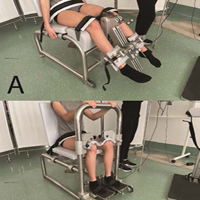Comparison between gymnasts and non-gymnasts in isometric strength of the lower limbs

Accepted: 5 March 2021
HTML: 8
All claims expressed in this article are solely those of the authors and do not necessarily represent those of their affiliated organizations, or those of the publisher, the editors and the reviewers. Any product that may be evaluated in this article or claim that may be made by its manufacturer is not guaranteed or endorsed by the publisher.
Authors
Muscle asymmetries in gymnasts are common and can lead to injury. We aimed to determine differences in hip, knee, and ankle strength between female gymnasts and non-gymnasts, and secondly, to determine the effect of strength training intervention. Fifteen gymnasts (aged 11.19 ± 1.89 years) and 15 non-gymnasts (aged 10.92 ± 1.96 years) performed unilateral isometric maximal voluntary contractions of the hip (extensor, flexor, abductor, adductor, internal and external rotator), knee and ankle flexors and extensors on a dynamometer. Inter-limb asymmetries (ILAs) were compared across strength outcomes (MVC torque) and groups. ILAs was calculated based on the strength measurements. The gymnasts were retested after 8 weeks, during which the participants performed 5 weeks of regular training and 3 weeks of targeted strength training intervention. We found significant differences between groups in most observed hip strength parameters, but not in knee and ankle strength. The intervention did not significantly affect any parameter of ILAs. Gymnasts and non-gymnasts differ in hip strength parameters. A longer intervention program may decrease ILA parameters.
How to Cite
PAGEPress has chosen to apply the Creative Commons Attribution NonCommercial 4.0 International License (CC BY-NC 4.0) to all manuscripts to be published.

 https://doi.org/10.4081/ejtm.2021.9663
https://doi.org/10.4081/ejtm.2021.9663



